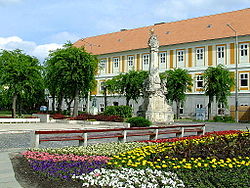Kalocsa
| Kalocsa | ||
|---|---|---|
 |
||
|
||
| Location of Kalocsa | ||
| Coordinates: 46°32′00″N 18°59′09″E / 46.53347°N 18.98579°E | ||
| Country |
|
|
| County | Bács-Kiskun | |
| Area | ||
| • Total | 53.18 km2 (20.53 sq mi) | |
| Population (2015) | ||
| • Total | 16,136 | |
| • Density | 326.42/km2 (845.4/sq mi) | |
| Time zone | CET (UTC+1) | |
| • Summer (DST) | CEST (UTC+2) | |
| Postal code | 6300 | |
| Area code(s) | 78 | |
| Website | http://kalocsa.hu/ (English) | |
Kalocsa (Hungarian pronunciation: [ˈkɒlot͡ʃɒ]; Croatian: Kaloča or Kalača; Serbian: Kaloča or Калоча; German: Kollotschau) is a town in Bács-Kiskun county, Hungary. It lies 142 km (88 mi) south of Budapest. It is situated in a marshy but highly productive district, near the left bank of the Danube River. Historically it had greater political and economic importance than at present.
Kalocsa is the Episcopal see of one of the four Catholic archbishops of Hungary. Amongst its buildings are a fine cathedral, the archiepiscopal palace, an astronomical observatory, a seminary for priests, and colleges for training teachers. The residents of Kalocsa and its wide-spreading communal lands are chiefly employed in the cultivation of paprika, fruit, flax, hemp and cereals, in the capture of waterfowl and in fishing.
Kalocsa is one of the oldest towns in Hungary. The present archbishopric, founded about 1135, is a development of a bishopric said to have been founded in 1000 by King Stephen the Saint. It suffered much during the 16th century from the invasions of Ottoman soldiers, who ravaged the country.
A large part of the town was destroyed by a fire in 1875, before buildings were constructed of more fireproof materials and when many used open fires for heating and cooking.
The Baroque provincial town in the Great Plain lies approximately 118 km (73 mi) south of Budapest on the east side of the Danube. The town is almost as old as the Hungarian state itself. After the Conquest, the tribe of Prince Árpád settled down here. Later, along with Esztergom, Kalocsa was an archdiocese founded by King Stephen in the early years of the Hungarian state. The first archbishop of the town was Asztrik, who brought the crown to Stephen from the Pope. In the first decade of the 11th century, the first church was built. In the Middle Ages history of Hungary, some generals served as archbishops. For example, Ugrin Csák (archbishop from 1219 till 1241) was the leader against the Tartars at the battle of Mohi 11 April 1241. Another significant general was Pál Tomori who was (archbishop from 1523–1526) the leader of the Hungarian army against the Turks. He was killed in an action at the battle of Mohács.
...
Wikipedia


